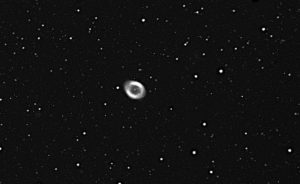In May 2013 I started a new project phase at Temple Research Observatory. For a number of years I have been interested in the Central Stars of Planetary Nebula or CSPN (see the Central Star of Planetary Nebula page). Back in 2010 I was trying to study the central star of M 57 using a 6 inch refractor. The six-inch refractor is a great instrument but it is very unwieldy to use and did not image as well as I would’ve liked, due to the weight and length of the tube, chromatic aberration and the lightness of the mount. The image below shows the Sirius mount of today, not the Celestron AS-GT is was mounted on then.

When a windstorm destroyed my mounting for the six-inch refractor I decided to upgrade the mount to a heavier (Sirius) mount that I bought on Astro-Mart. I also purchased a new optical tube as well. The optical tube was an Astronomy Technology 8 inch F/4 Astrograph. One of the problems with the six-inch refractor was its small field of view. This was good for seeing the details of the central stars of planetary nebulae and planets, but it was very difficult to find comparison stars which are needed to measure the brightness of the target star.
Many of the CSPN do not have any standard comparison stars through the AAVSO or any other resource. Without these comp stars it is a pain to make other stars in the field of view are usable. It turns out that even when there were comparison stars, most were not in the field of view of the six-inch refractor. So when I upgraded I decided to get a telescope with the larger field of view.
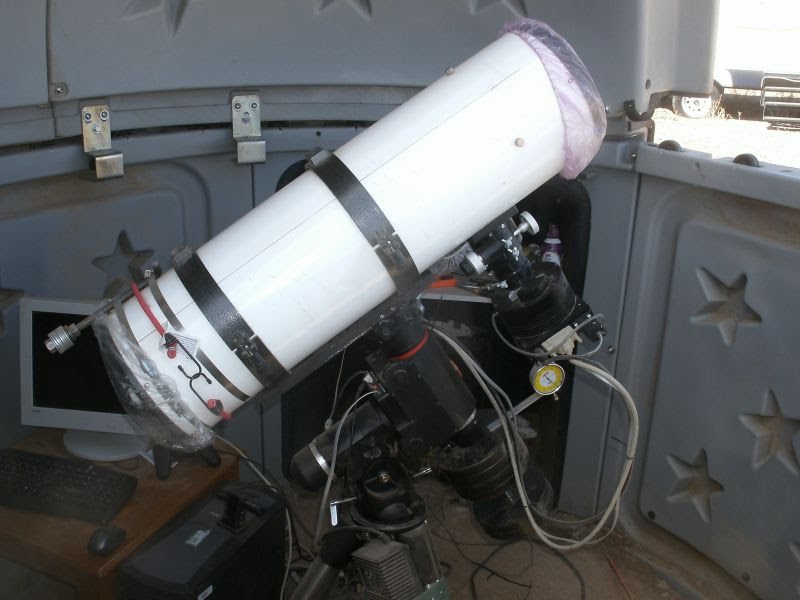
The 8 inch astrograph has a field of view that is 29×19 arc minutes with the ST-7E camera. The full moon is approximately 30 arc minutes in size. This made finding comp stars much easier. Though the AAVSO now has a program where you can request comparison stars, the wide field of view made it much easier to find stars on your own if need be. The trade off for this is a lack of detail in your objects. For example I could see the CSPN of M57 very easily in the 6″ but in 8″ AT F/4, the M57 CS is so small that it is hard to see at all and has a poor S/N (Signal to noise ratio) because of the nebulosity.
The bulk of the observing over the next few years had been a trial period, making sure the instruments were working well enough to do professional quality work and perfecting data reduction techniques. One of the projects that I used, to check precision, was studying over- contact binary stars in the northern sky. Since most professional instruments have difficulty looking in the area around the North celestial Pole this is a good area for amateurs to study. By studying these stars I was able to determine the precision of my observations. My precision level was around .01 (10 millimags) of a magnitude accuracy. This sounds good but Bruce Gary in Sierra Vista, AZ, who hunts for exoplanets is getting 1-2 millimags (.001 or better with amateur equipment. In the spring of 2014 I was awarded a certificate for uploading over 1000 CCD observations to VSX at the AAVSO. Most of these were time series of contact binaries that had little or no other observations other than the original survey that found them.
Over 1,000 CCD Observations*
Michael J. Cook Canada 2010-2013 7,611
Ivan A. Curtis Australia 2012-2013 5,623
Pierre Hallsten Sweden 2012-2013 5,212
Vesa Tapio Kousa Spain 2012-2013 4,779
James B. McMath USA 1992-2013 4,668
Thibault de France France 2013-2013 4,367
Alfonso Carreno Spain 2012-2013 4,057
Thomas Wikander Sweden 19 2010-2013 3,075
David S. Conner England 2009-2013 2,388
John Centala USA 2002-2013 1,870
Helmar G. Adler USA 2013-2013 1,777
Maurice Audejean France 2011-2013 1,741
Kevin Hills England 2012-2013 1,573
Fabio A. Mariuzza Italy 18 2007-2013 1,558
Andras Timar Hungary 03 1992-2013 1,425
Paul Temple USA 1996-2013 1,375
In 2013 I was invited to speak at the Silver City astronomy club. My talk was on my interest in the Central Stars of Planetary Nebula. I saw a guy sitting at a table and he had some scientific looking papers in front of him. I didn’t think too much about this since people bring lots of things to astronomy club meetings. As my talk was progressing I mentioned some of the people that had helped me in this project. One of them was Howard Bond of the Space Science Institute and I had used several of his papers in other presentations. At this point the gentleman raised his hand and proceeded to mention that I had forgotten an important person. It turns out that Dr. Al Grauer was the one who designed the instruments and was the primary investigator for most of Howard Bond’s projects. The gentleman was Dr. Al Grauer himself! The two papers that he brought were papers on the characteristics of CSPN that he and Howard had studied. Somehow I had had missed these papers in my research. To make it even more bizarre, Al was a coworker of my friend Rik Hill at the Catalina sky Survey on Mt. Lemon. So Al had known about my project before I was asked to speak at the meeting. Al mentioned that I was on the right track in my studies and he “liked my work.” This was an encouraging confirmation of a project that many see as a waste of time.

Most of 2013 was a study of two targets in the northern sky fairly close to the North celestial Pole. NGC 40, the “Bowtie” nebula (V0400 Cep) and NGC 6543. These were placed well for observation from TRO Deming. One of the problems with the POD (personal Observatory dome) is that you cannot image at the Zenith (straight up) or you may have to move or even remove the dome. Since my telescope is a robotic telescope I don’t want to have to wake up in the middle of the night and move the dome or take it completely off. With the wind we sometimes get it is a good idea to be able to close up fast when need be and taking it off is not attractive either. So by observing objects in the North, going around the pole, you can bypass having to mess with the dome at all. The other thing that’s good about these two objects is that they have a small amount of nebula around them and the central star is quite bright. This makes the process of doing photometry much easier and more accurate.
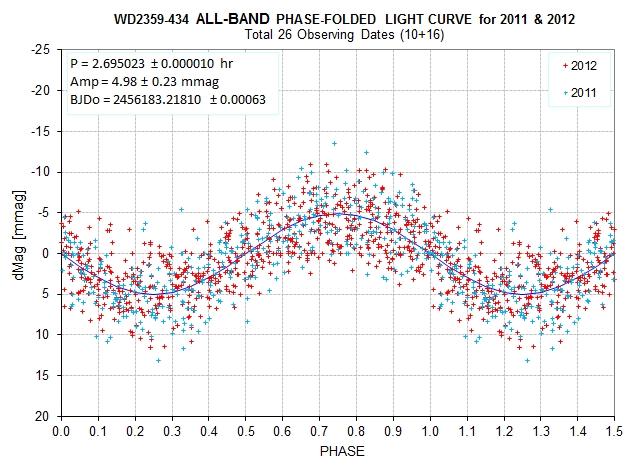
The preliminary studies show the characteristic sinusoidal light curve of some white dwarf stars. There are lots of variations on the light curve that are unexplained by current models. Bruce Gary the exoplanet hunter has just completed a study of over 40 white dwarf stars and found a number of them with similar light curves. There seems to be a pattern here and as an amateur I can spend the time necessary to add to the science. My hope is by concentrating on these stars it will make some of the astrophysical processes clearer. Some of the theories are; brightening of an accretion disk, gravity wave effects or spot fusion in the hydrogen atmosphere. All of these are very intriguing ideas and are not being observed by very many other observers right now. The images below show the objects being studied. The larger image is straight off of the camera (the large blob in the middle is the CSPN) and the smaller is from a camera image of NGC 40 but has been cropped/enlarged to show detail. The graphs are the brightness of M 57 that I have been studying in 2014.
In February 2014 I took a new job at McCurdy Charter School Teaching high school science. I sold the POD (it financed our move!) and retired the 8″ F/4. After much testing and work TRO Espanola was built! A slide off shelter was made from 2×4’s and covered with canvas. Eventually it was remodeled with 1/2′ press board sides.
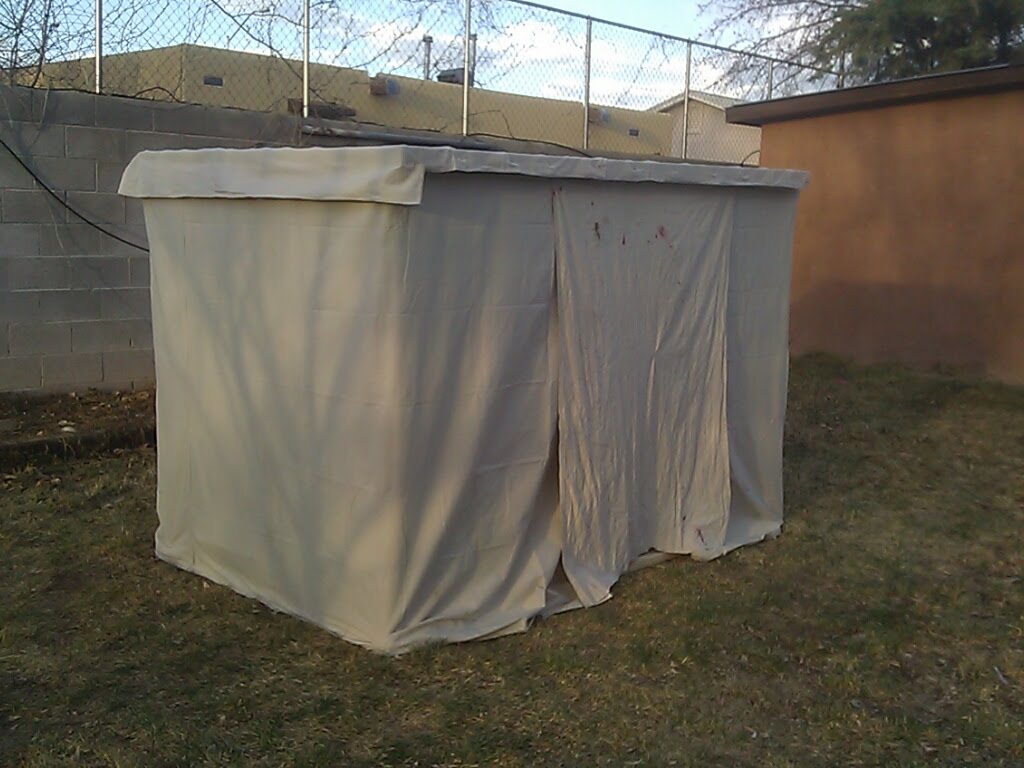
In March of 2014 TRO began studying CSPN’s with a new telescope in Espanola, NM where we lived until June 2016. It is a C11(11″) Schmidt-Cassegrain with a custom carbon fiber tube, Moonlite Focuser, SBIG ST-2000 medium format camera, CFW-8 filter wheel, Sloan photometric filters, hypertuned mount and full robotic-control software. It is a pleasure to work with a fork mount! I find the meridian flip of an equatorial mount to be somewhat of a pain, at least with the Sirius mount and EQASCOM software. Seldom does the mount return to the right field of view no matter what you do! Even with T-point the images after a flip were often unusable. With a fork mount and autoguiding you can pretty much keep a star on the same pixel all night long! Much better photometry that way. There are some new images with the new camera in the pictures on the “Pictures from TRO” link.
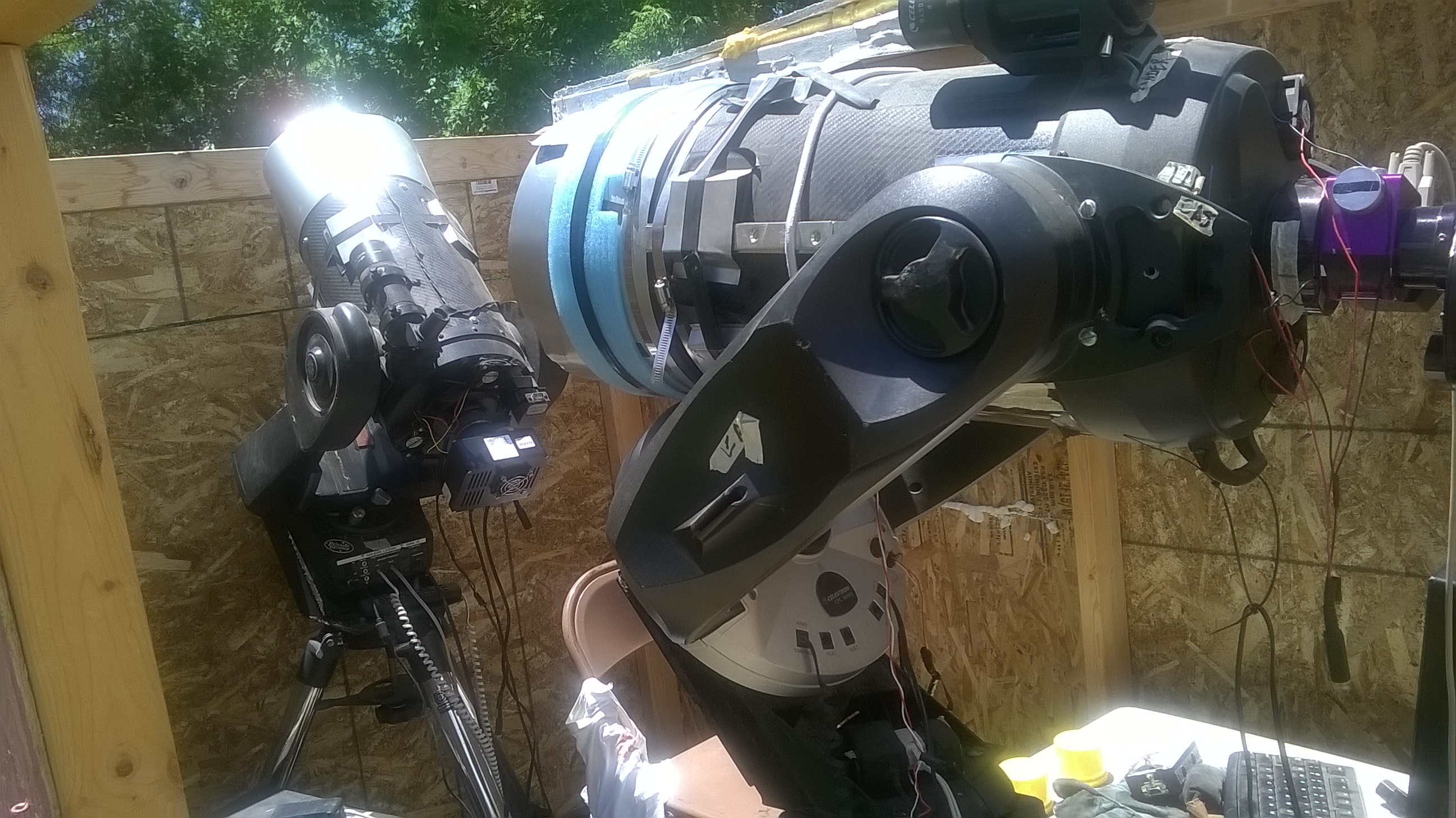
After several months of work the 11″ was up and running. It would usually only image a few hundred images a night instead of the 500-600 it was capable of. There always seemed to be some type of guiding or tracking issue that would crash the programming and limit the run. Then the SBIG ST2000 CCD camera that I was using caught fire! Slagged the video chip and I had to go back to my old SBIG ST-7E with a much slower upload and smaller field of view.
In June I got several long time series of the CSPN of M 57. At this point It would seem that M 57 data is still not definitive. Better data will come from CSPN that has less nebulosity or better technique. The nebula is pretty but makes doing photometry very hard! One technique that I tried is imaging in near infrared. The 8″ was just too small to effectively image in infrared but it is easy with the 11″. In fact the original M 57 images taken with the Wright 28 scope, an identical twin to Temple-28, were done in infrared. This clears up much nebular interference and makes the light curves smoother.
The images below are preliminary images done on Maxim DL. The horizontal line in the middle is the CSPN in M 57. You can see a small amount of variability buried in the “noise” of the nebula. This noise is caused by the star being embedded in a bright nebula that skews the data reduction process. The big spike in the middle is a satellite that went through an image! Though this data is too noisy to fairly represent a definitive light curve of M 57 it is enough to show that this CSPN is a micro-variable and not a visual variable star.
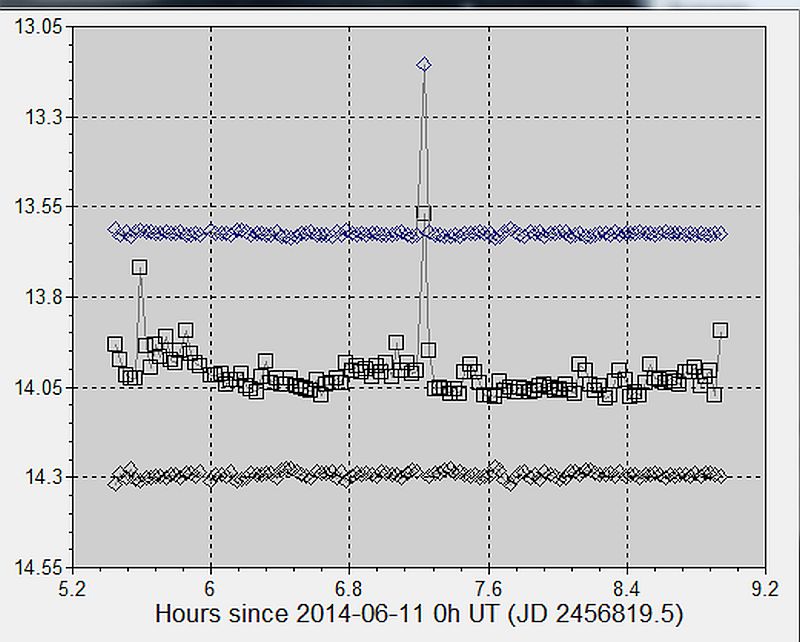
A new phase of TRO is starting. After retiring, again, from full time ministry in July 2016 I was called to be the senior pastor of a church of 160 attenders in Lexington, MO in March 2017. This has been an exciting development professionally but somewhat a challenge to do astronomy. Our house is on a hill with a historic cemetery directly behind the back yard. Though it is the best view of the sky in town it still suffers from a large amount of light pollution and excessive water vapor. Since we live in a rental house I needed something that was not permanent to protect the telescopes. This has led to attaching the scopes to concrete embedded screws and covering them with heavy covers. Surprisingly enough this setup has worked well in all kinds of weather, including 70 mph winds and rain.

Data has been accumulating for several years on the CSPN project. This data makes a good case for small amounts of variability similar to that found on many cooler white dwarfs. This corroborates work done in the 1970’s and 80’s.
In April of 2019 I was privileged to present a paper at the Mid-America Regional Astrophysics Conference on the Central Star of M 57. The paper was well received but it became very apparent that astronomy researchers are moving rapidly in another direction. Most of the talks were about statistical studies of galaxies and how a computer can automatically classify them. Things like, calibration frames, darks, flats and light curves were new territory for many of the attendees!
Below is the link to the “Chasing Dwarfs” PPT for MARAC.
“Citizen Scientists” can play a huge role in today’s astronomy. All of the mysteries of the stars and planets have not been solved by the professionals leaving much of this field to amateurs. Over the counter equipment and low cost telescopes can replace the mega-expensive professional equipment of the past. With the availability of low cost cameras and scopes serious research can easily be done by the lowly sky gazer of today!
